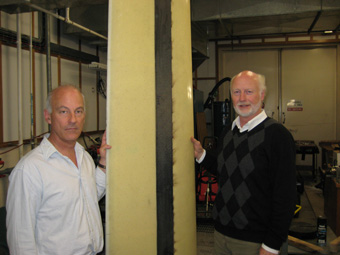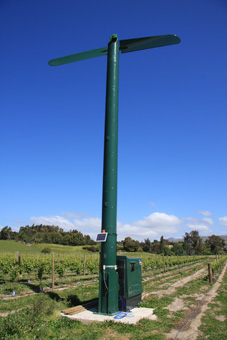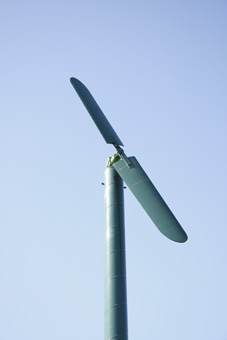Custom designed blade revolutionises frost-fighting wind machines
Tuesday 16 December 2008, 11:37AM
By Helen Shea
2,664 views
The new Defender wind machine featuring a revolutionary custom designed blade is set to halve the noise from wind machines used to protect vineyards and orchards from frosts.
Concerns about noise pollution have been raised throughout the country as wind machines become a popular and effective means of frost protection. The machines drive the warm air that rises from the ground keeping it at ground level to minimise, or prevent, the formation of frost.
Marlborough company FMR Group has been working with the University of Canterbury for the last 18 months to reduce the noise level of the wind machines and have achieved a more than 10 decibel reduction.
The result is the Defender wind machine which will be in production from February 2009.
Developed from the FMR’s tried and tested Amarillo machine, the Defender will be available for installation for the 2009 spring frost season. And like the Amarillo, the Defender will have the benefit of the company’s 24 hour back up service.
FMR Group Ltd managing director Chris Clifford said they recognised the noise coming from wind machines was becoming a real issue and were keen to find a solution.
“We turned to the University of Canterbury’s Department of Mechanical Engineering because it’s one of the few places in the world capable of developing the type of technology we needed for this project,” said Chris.
The Department’s Acoustics Research Group measured and analysed the noise levels from the FMR Group Ltd’s existing Amarillo wind machines.
This information was used to develop a method of predicting the noise levels and associated air moving performance of the existing wind machines based on the blade geometry and operating characteristics of the machines.
Dr John Pearse who led the Acoustics Research Group said using this prediction method they designed, manufactured and then tested a new blade which provided a substantial increase in air moving performance along with much lower noise levels.
He said Defender’s new blades are the same length, but have a different shape and rotate slower.
“The blades are constructed from a carbon fibre composite which provides the required strength while enabling the required blade shape to be obtained.”
Dr Pearse said they were able to use the FMR Group Ltd’s experience and expertise in wind generated noise, noise measurement and prediction techniques as well as their acoustic facilities to develop the quieter Defender wind machine.
“The blade we have developed not only results in the wind machine being about half as loud but the noise has a more pleasant character and is consequently less intrusive.”
Dr Pearse was impressed with the FMR Group’s commitment in addressing something that has been a real issue for vineyards and orchards.
“Not every business is willing to take this type of technical risk but it has really paid off and I am very excited with what we have been able to come up with for Chris and his team.”
Field testing of the prototype blade has been underway for the last year with final noise and performance testing expected to be completed and fully documented this month but already Chris Clifford said he’s delighted with the outcome.
“The new blades not only offer a huge reduction in noise but also increase the performance of the wind machines.”
FMR Group has worked to develop a wind machine which is specifically suited to the requirements of the pacific region, with the latest model offering a composite engine enclosure, a new computer management system that allows full remote monitoring and control and the new low noise, high performance blade.
“This was always a two pronged approach, our customers are looking for increased performance levels and maximised efficiency, as well as a reduction in noise output and the Defender’s new design provides both.
“While the cost of research and development into the new blades has been significant, the results prove the money was well spent.
“The major improvements mean we already have a high level of interest in the new blade from new and existing customers both here and overseas,” he said.
“While the blade was primarily designed for the New Zealand and Australian markets there has already been interest from USA and other countries due to the improvements we can offer.”
The new Defender wind machines will have a number of benefits for those in the rural sector. The performance increase means less machines will be required on each property and in colder areas frost fighting performance will be increased. In addition the low noise output will substantially reduce complaints and issues with neighbouring properties and will allow machines to be installed into areas where traditional designs are too noisy.
While the new blade design will be standard on all Defender wind machines, FMR Group has recognised there is a substantial demand for a retrofit option to install on existing wind machines and these will also be available next year.
Wind Machine Background Information Sheet
Specifications of Defender’s new custom designed wind machine blade:
Length of blade: 6.36 m diameter
Chord length: 635 mm at the blade root, 505 mm at the tip
Noise level: half as loud as existing wind machines
The Marlborough District Council Plan generally requires wind machines to have an LA10 of 60 dB or less at 300 metres from the wind machine.
There are more than 1000 wind machines installed in Marlborough, with maybe as many again in other parts of New Zealand and thousands used worldwide.
A wind machine typically protects an area of approximately six hectares depending on the severity of the frost event. This means one wind machine can be protecting a crop worth approximately $120,000 in each and every frost event, over twice the value of the wind machine. One frost can wipe out an entire crop for the year as well as cause damage to the vines that impacts on future crops. Therefore it only takes one frost event to more than cover the cost of a wind machine at current crop values. Using this calculation, it’s estimated the wind machines installed in Marlborough are protecting a total crop value of more than 100 million dollars.
FMR Group began importing the Amarillo wind machine into New Zealand in 2002. Amarillo Wind Machine Company, based in California, USA is a subsidiary of Amarillo Gear Company from Amarillo, Texas. Amarillo Gear has a worldwide reputation for manufacturing top quality gear drives.
FMR Group has developed a wind machine which is specifically suited to the requirements of the pacific region, with the latest model, the Defender, offering a composite engine enclosure, a new computer management system that allows full remote monitoring and control and the new low noise, high performance blade.
One of the key reasons for the success of the FMR Group wind machine is back up service. Since the first frost season, FMR has been committed to supporting its customers during a frost event. Whilst it is rare for any issue to occur, as with all things mechanical problems can arise and when they do, minutes counts. The most common cause of a machine failure is flat batteries or insufficient fuel but FMR technicians in Marlborough and those of the various agents around New Zealand are equipped with the knowledge and spares to affect a prompt repair in almost every case. With the latest computer system, this service can be taken one step further as the wind machine can be monitored from a remote location and all significant operating parameters can be set to alert a manager or technician in the event of a problem arising.
FMR Group is preparing for a busy season in 2009 as the company’s new Defender wind machine offers the highest performance and lowest noise output of any machine on the market and it is likely demand will be strong.


